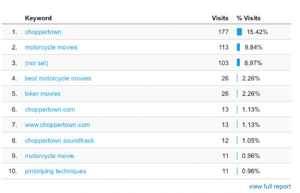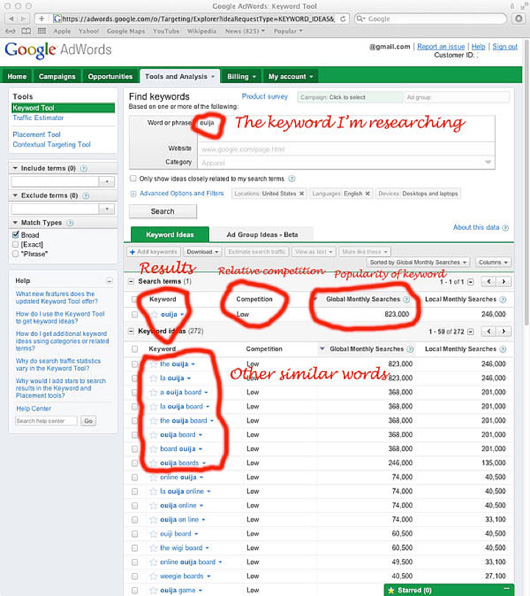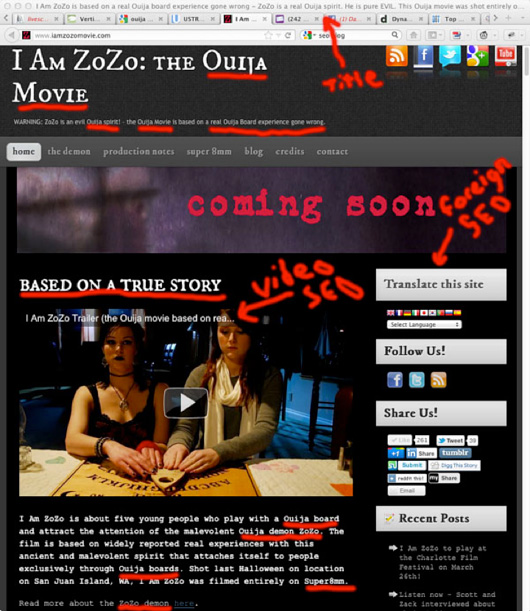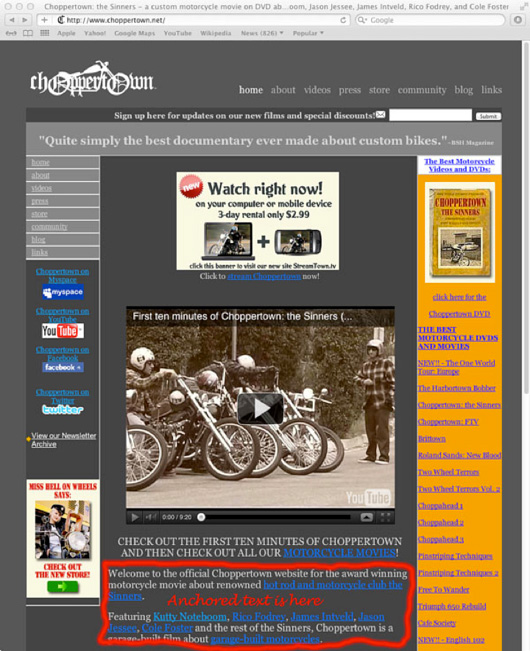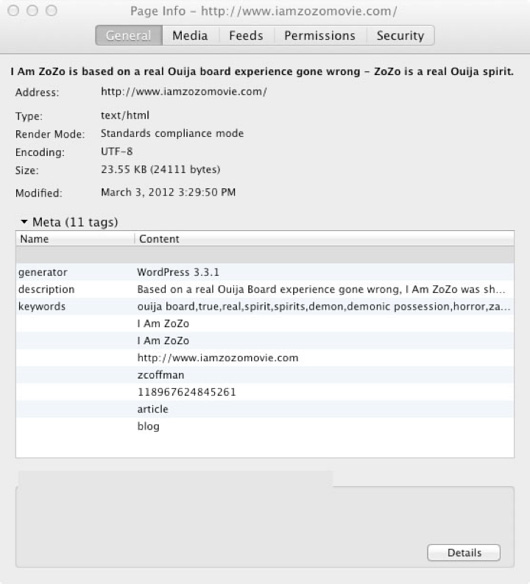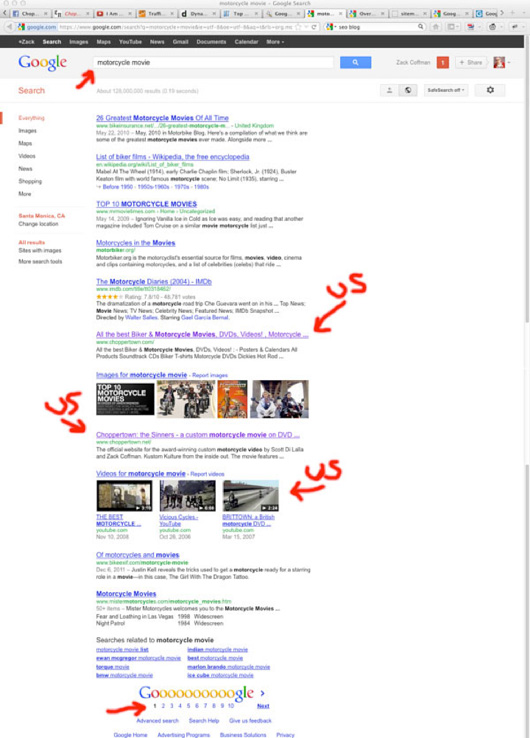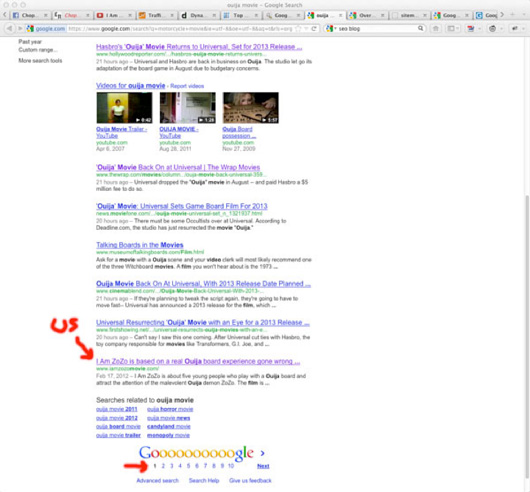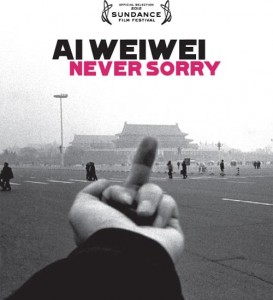
SEO: Lifeblood of the Indie Filmmaker
This post was written by Zack Coffman, Co-founder and President of independent film company One World Studios Ltd.; a feature film production and distribution corporation in Los Angeles. It was originally published by The Film Collaborative (TFC) on the Sundance Artist Services blog.
As indie filmmakers, we often don’t have millions of marketing dollars (or any at all) to spend on turning our films’ titles into household names. Getting “organically” ranked highly by Google and other leading search engines is the single most cost-effective way to created a sustained marketing presence for your film.
SEO, or Search Engine Optimization, is akin to a dark art that every savvy website owner undertakes in an effort to get their site(s) ranked highly by Google, and to a lesser extent Bing and Yahoo. To be put in the top five most highly-ranked sites in a given category is the Holy Grail of SEO. Appearing “above the fold” before a Google user needs to scroll down to see more results gives the website a nearly priceless stamp of approval by Google’s secret algorithms and is worth hundreds if not thousands of times more than any kind of paid internet marketing, hence the steady stream of spam emails we all receive from SEO “gurus” promising to get you more highly-ranked for a big time fee. At the end of this article I’ll give you some great resources to get started on your own. Note: While it’s not our full-time gig, my company would also consider choice projects for SEO analysis on a limited case-by-case basis.
Most of what we’ve learned here at our indie film production and distribution outfit has been through hours and hours of internet research as well as even more hours spent trying different strategies on our own bevy of sites across our One World Studios Ltd. brands. That said, any SEO expert worth their salt will tell you that Google is constantly tweaking their ranking algorithms and introducing varied ways for sites to be tracked and ranked so what works one day may not work forever, thus making SEO truly a dark art! The following basic tenets have worked for us however, so let’s begin.
To start with:
Your domain name is the number one thing Google looks at when it starts to judge your worthiness and appropriately index your site. Many films use their title with “movie” or “-movie” after it so Google knows that it’s a film. You can get more creative if you like however if you think that people may search for your film with different words than the film’s title or if you have some kind of catchy phrase associated with your film that is more memorable than the title by itself. I’ll be using our sites as guinea pigs today so let’s start with our new Ouija movie, I Am ZoZo; a feature that we shot entirely on Super 8mm. For this film we registered the domain www.iamzozomovie.com and for our previous motorcycle movies a couple of our highly-ranking sites are www.choppertown.net and www.choppertown.com.
Now that you have a site to work with it’s important to set up Google Analytics and Google Webmaster Tools so you can be indexed properly and you can see how your traffic is reaching you, etc. allowing you to make changes and tweaks over time. Also, make sure you have an updated sitemap.xml file in your site’s root folder, this is very important to be indexed by Google. A sitemap essentially gives Google’s “spiders” and “bots” an instant and cursory understanding of how all the various pages of your site are interlinked with one another so that it can place you in the proper category quickly and efficiently. Use this site to generate a sitemap now. Here’s ours for iamzozomovie.com.
Now that we’ve prepped our site, let’s get our hands dirty:
When building/rebuilding your site it’s important to take stock of what you have and what you want. Take a step back and determine what your site is for; does it sell something like a DVD or book? Does it provide information to other people? Is it exclusively for promotion of your film? Once you’ve determined that, sit down and start making a list of various search terms and keywords that you’d like to be found under in Google. (Use the Google Analytics tab “Traffic Sources” to see how people are currently actually finding you.)
Remember, it’s relatively easy to get highly ranked for the title of your film or brand if it’s original or novel, but the real key for the indie filmmaker is to get ranked highly for words more general than your film’s title.
From Choppertown.com’s analytics showing how the site was most recently found:
Another example: I Am ZoZo is about a Ouija board possession and it was shot entirely on Super 8mm so we have several interesting “hooks” and terms that we feel we’d like to be found under. By signing up for AdWords (optional) and using Google’s Keyword Tool, we can see how many times some of our various ideas for keywords are actually being searched and also what kind of competition exists for advertising under those keywords.
Hint: More general words may seem to be more desirable and they’re certainly more costly for advertising, but they aren’t always better for your site because the traffic you generate may not be “qualified traffic”. Just getting tons of people to look at your site doesn’t mean as much as getting tons of people who really like your content to visit your site.*
So in this example I searched for the most general term I could think of “Ouija” and luckily, it’s not very competitive, but reasonably popular. Now do this for each site you own andeach individual page of each site. Write down all your favorite terms that apply to each page of content you have and get ready to apply them to your site.
If you get one useful tip from this article it’s this: Google likes it when each page of a site has proper indicators as to the specific nature of the page’s content and content that matches those indicators.
Now let’s see how it’s done:
We now have a list of various keywords for our main index (Home) page ranging from general to specific such as: Ouija, Ouija boards, the Ouija, and La Ouija (never would have guessed this one), Ouija game, and down the line. Also since it’s a film, we want to add in words like: movie, movies, videos, media, caught on tape, real stories, etc. That’s just the Home page, we now go through each page of our site and try to think of different, but still related, words that we want each page to highlight.
In the example of I Am ZoZo, we shot the entire film on Super 8mm, which is quite different (yes, some have even called it crazy.) Google loves unique content because usually readers do too, so I’ve set up a page focusing on the production aspects of our film that don’t relate to the story of the film, but rather the fascinating experience of shooting on film in general and on Super 8mm in particular. Our story is based on true Ouija tales we collected over the years so this becomes another unique page and so forth. Remember, the idea is to show Google that your site has both interesting and unique content that really relates to what it claims to be about.
Note: Some SEO scam artists make fake pages on your site that are filled with just keywords and little or no original content. Beware these scams because if the Google bots discover it they can ban your URL permanently!
Now that you have the basic layout of your site and what each main page is going to be about, get down to writing content that uses the keywords you chose to focus on. Google loves text, so feel free to write lots of appropriate and useful information for your readers. As always, “content is king”. This is tricky because A) writing isn’t easy…and B) just because Google loves tons of text, your site still needs to function well in regards to UI (User Interface). In layman’s terms; your site needs to be good for the visitors, not just Google bots. The combination of the technical and creative has always fascinated me, so I enjoy working this piece of the puzzle on my own sites. It definitely takes practice, with constant updating and critiquing from friends and colleagues to find the effective mix that makes both your readers and Google happy. Hint: Also give credence to paragraph headings and section headings within each page because Google looks at them to further index the context of the content on your site.
Examples of keyword usage above the fold on the I Am ZoZo website:
More technical details:
Anchored keywords (Anchor Links) and hot-linked words are also important ways to indicate to the “bots” that certain content on your site is more important and to be focused on for indexing. (This is also an important part of your Social Marketing strategy which may be the topic of a future article since it needs its own focus and attention.) The gist is this; if you have a page on your site, either a top-level page or deeper level pages, you can and should occasionally make a link in your text to those pages if they relate directly to the content. For example, on the front page of our website relating to our first motorcycle movie “Choppertown: the Sinners”, you can see lots of text and anchored links leading off to other sites we own as well as deeper into the Choppertown.net site itself.
*I know you’re saying, “Dude, that site looks so ten years ago!” True, the format might be due for an update, but Google LOVES this site because the information is accurate and text-based so we use it to help pull up our other motorcycle movie-related websites and social network. Note: Google loves older sites and this one has been around since 2004, so if you give the SEO treatment to an older site you can expect bigger gains. Also note all the targeted keywords used on this page such as: Motorcycle Movies, documentary, custom bikes, motorcycle videos, etc.
Digging Deeper:
Now that we’ve tried to fill our site with compelling, well-written, smartly-keyworded information it’s time to go behind the scenes and make some more improvements that Google demands. You need to make sure each page’s “title” is descriptive and full of your most important keywords. The title is what appears in your browser, way at the top above everything else in the grey area. Google looks at this as much as anything else! (Remember it then matches that info against what it perceives to be the actual content of the site, so again SEO spammers beware.)
The title for Choppertown.net reads: Choppertown: the Sinners – a custom motorcycle movie on DVD about biker culture featuring Kutty Noteboom, Jason Jessee, James Intveld, Rico Fodrey, and Cole Foster.
Notice it has our most important keywords first. It’s a bit longer than Google normally likes (15-20 words) but close enough. We wanted to put in the names of some of the more well-known personalities from our film so anyone Googling them will also find the film.
From IAmZoZomovie.com: I Am ZoZo is based on a real Ouija board experience gone wrong – ZoZo is a real Ouija spirit. He is pure EVIL. This Ouija movie was shot entirely on Super8 mm.
Remember, do this for EVERY page on your site. Blogs and other template-based site programs have spots for you to enter this information, usually right at the top. Hint: On blogs your post’s titles are already used for this, so plan your blog posting titles accordingly!
Note about menus headings: As with Anchor Links, the words you use for your Menu Headings are important as well because Google looks for certain “standard” words that it can index quickly. For instance: Home, About, Contact, Store, and Blog are very common. Both from a user perspective and Google perspective try not to monkey around with these too much. However, where a lot of people fall short in terms of SEO is they leave the menu name as the title of the page. This is the case if you look at the grey bar at the top and you just see “Contact” or “About”. This tells Google no specific information about the page and is a wasted opportunity for SEO.
Digging even DEEPER:
Visit a website you like – or even your competitors’ sites – and then select “Get Info” from the menu bar (⌘-I on a Mac, Control-I on a PC.) The little window that pops up has all sorts of useful information.
At the very top is the title as we discussed. Below that is “description” and “keywords” or “tags”. There are places to enter this info on each blog post or web page you make. Again, they should be DIFFERENT for each page/post and APPLICABLE to their associated page. Try to put in keywords for each page that you really want to stress to Google are important. The description is also indexed and important for all the above reasons, but it serves a very important marketing purpose as well; it’s the sentence or two that you see when you do a search on Google! So it’s important to make this BOTH Google friendly and reader friendly so that the reader will actually CLICK your site’s link after they find it. (Yes, Google does consider POPULARITY in its ranking algorithms.)
Yes, it’s a Popularity Contest:
Google also adds into its algorithm the amount of traffic that goes to your site and where it’s coming from. HUGE WARNING: Those SEO spammers that have been emailing you often mention “link-building” and the like. Stay away from them unless you have already vetted the company because many of them create link farms of random junk websites just to provide you with thousands of inbound links. When Google’s bots realize this they PENALIZE YOUR SITE. Getting quality inbound links takes time and effort and some companies are willing to help you for a fee, but honestly you are your own best judge from what other sites in your space you would like to get inbound links. Any time the New York Times or IMDB or Hopeforfilm writes an article and links to your site (hopefully with Anchor Text) Google perks up its ears and moves you up its rankings because it already deems those sources as worthy. Hint: A good technique is offering original articles to various blogs you like in exchange for cross-linking each other’s content. If your site is still small and the other is huge it may be a bit of a Catch-22, but we all know the indie film business is about jumping hurdles as we come to them! If your article is interesting, the bigger blog might just reprint it and link back to you.
More Technical Details – A great technique not for the faint of heart:
(Before trying this technique BACK UP YOUR SITE. Really!)
Every page of every website in the world is actually a file document (similar to a Word or Excel document that ends in .doc or .xls, web documents often end with .html) Instead of your written content only, each web page file also contains lines of code that tell a web browser how to present it to the end user on a computer screen, tablet, or cell phone, etc. The actual File Name of the page file is a big determiner when Google scans your page. For instance, you design an “about” page and fill it with all sorts of useful information about your film, then you go in and add all the other details we’ve discussed such as a descriptive title, keywords, etc. Don’t just save it as “about ” even though your page’s menu has an “about” button leading to this page. Instead call it for example, “best-your movie’s subject-movie” or the like. As long as the file name is still somewhat related to your actual content, Google will love it. On our film’s site the “about” section’s page is called best-motorcycle-movie.html.
A word on Page Speed:
Recently Google made it public that they also factor in your page’s loading speed when determining rank. This is a new development and in response to both the increased use of cell phones and tablets for internet browsing as well as the ever shrinking bandwidth of the internet “pipes” as more and more sites and users get online. There are a million ways to make your site load faster and many of them require some technical knowledge to fix, but a good place to start is by running your site through http://gtmetrix.com and researching the errors it comes up with. After reading Google’s announcement about speed and rankings, we put all our sites through the test and found lots of little problems that needed fixing. We went from a 69% “D” rating to an 86% “B” after addressing some of the simpler issues. That’s the thing about SEO, it requires constant vigilance and tweaking!
A picture is worth a thousand…and a video is worth a million:
It’s important to address the images and videos that are a mandatory component of any filmmaker’s site. Remember Google has separate search sections for both images and videos and you want to be found there as well!
First, it’s important to make sure that all images have been properly “optimized” for web use either through Photoshop or a cool WordPress plugin like “smush.it” so that they will be small in size and load very quickly. Make sure each image’s file name is SEO friendly by naming it something descriptive like “I Am ZoZo-keyart” or “Choppertown-motorcycle-DVD” and make sure you add all requested metadata when you upload it. Usually your design program has places for you to input this data such as “description”, “caption”, and “tags”. Fill out everything to give Google more to chew on!
The same goes for video. I recommend uploading your clips and trailers to YouTube and then embedding that onto your site (I know Vimeo looks better) but let’s face it, you want YouTube is Big Daddy when it comes to sharing video and you want every click to count! (Also Google owns YouTube so it tends to offer up those videos first in search for better or worse.)
SEO and getting clicks for your video is probably its own article too, but many of the same steps apply; how you name your video is key so call it something that has the keywords for how you want to be indexed. Don’t just call it “I Am ZoZo Trailer”…call it “I Am ZoZo Trailer (the Ouija movie based on real experience gone wrong)”. Fill out a good description for it (with a link back to your own site of course!) and put in lots of appropriate tags.
Last Step:
Every time you change anything on your site, make sure you update your sitemap.xml file and then resubmit it to Google! This lets Google know that your site is active and attempting to provide current information to readers.
To Sum it All Up:
- Choose a useful domain name
- Register for Google Analytics and Webmaster Tools
- Check that you have a sitemap.xml file and make one if you don’t already have it
- Make a list of keywords
- Write great content with Anchor Links
- Make sure all your site’s page titles are appropriate, short, and descriptive
- Add your metadata such as descriptions and tags
- Get inbound links from qualified sources
- Check your pages’ file names (optional)
- Optimize your pages for speed
- Do SEO on all your images and videos
- Update your sitemap
The Proof is in the Pudding:
So after all that work, here’s the results… Not one, but three of our sites are listed on the front page of Google under the coveted and targeted term “motorcycle movie”.
..And we’ve even made it to the front page for “Ouija movie” as well. Note: We were ranked even higher until yesterday when Universal announced that it is going into production on a low-budget Ouija movie of its own. Like I said, it’s a constant battle but honestly I wouldn’t have it any other way.
Thanks as always to our supporters who help us keep the dream alive.
Resources:
Top-ten SEO Blogs as listed in the article “Top 25 SEO Blogs” by Daniel Scocco of Daily Blog Tips.
- Search Engine Land
- SEOBook
- SEO Moz
- Matt Cutts
- Search Engine Watch
- Search Engine Roundtable
- Search Engine Journal
- Online Marketing Blog
- Pronet Advertising
- Marketing Pilgrim
Special thanks to:
Allen Chou of indie distributor Passion River Films who first mentioned the word SEO to me back in 2006 and Eric Leuenberger of Zen Cart Optimization who gave me lots of great SEO advice around the same time.
…and of course Orly Ravid’s Film Collaborative, a fantastic indie film resource.
About One World Studios Ltd:
One World’s first feature documentary “Choppertown: the Sinners” focused on a renowned group of California bikers known as the Sinners. Produced in 2004 with a stack of credit cards, this award-winning documentary heralded a return to the values of a simpler time and spawned a worldwide cult following culminating in a seventeen-country European theatrical tour sponsored by Dickies. After selling 20,000 Choppertown DVDs out of an apartment in West LA, One World principals Zack Coffman and Scott Di Lalla were able to quit their part-time jobs, making and distributing films full time since 2005. “I Am ZoZo”, the award-winning Ouija movie shot entirely on Super 8mm, is their sixth feature and first narrative.
About Zack Coffman:
Hometown: Dundee, NY Education: UCLA (World Arts & Cultures), Yonsei University Korean Language Institute. Resided in Seoul, Korea from 1992-2000. Professional highlights: Head of Acquisitions, HMJ Films (Korea.) Asian correspondent, Variety. Line-producer and location manager for several Korean films including Korean/Philippine co-production Weekend Warriors. Translator, Korean International Trade Association. Co-founder and President of independent film company One World Studios Ltd.; a feature film production and distribution corporation in Los Angeles.
Contact/Follow Zack Coffman: Facebook, Twitter, zack@choppertown.com
Orly Ravid April 17th, 2012
Posted In: SEO
Tags: domain name, Google search, I am Zozo, independent film, keywords, link building, low budget film, Marketing, One World Studios, online film promotion, search engine optimization, SEO techniques for fiilm, traffic sources, Zack Coffman
What The Film Industry Needs: Transparency
This post was originally published on the Future of Film Blog of Tribeca Film Festival on April 9, 2012
Recently I was helping a friend with a business plan related to publishing. So naturally I needed to reference revenues in the publishing space. There was plenty of revenue data available. However, when one reads film business plans one knows that data is often unreliable, unverifiable, or misleading. In my dealings with people from other professions and others in business, it always seemed to me that sharing real information was considered good business and led companies to learn from others.
I’m sure there are plenty of business that do not function transparently, but after 13 years in this one, I can say I know why people hide real information and why it’s bad for the film industry as a whole.
Box office grosses can be verified to a great extent but P&A expenses cannot and now with VOD revenues, it’s anybody’s guess what really happened except for those seeing the actual reporting (and even then…). When DVD was a key revenue generator, one could at least get a lot of the main sales data via VideoScan. It covered the retail brick & mortar sales numbers and Rentrak covered the rental business as well.
In today’s digital distribution market, which ranges from VOD, to iTunes and other smaller online outlets, the numbers are hard to find or verify.
Most of us probably criticized the mysterious banking practices that led to the economic downturn within which we are still presently mired. Yet the film industry perpetuates a system that hides information and makes the data mysterious when it should not be. This mystery and obfuscation leads to incomplete or inaccurate business plans, an uninformed investor pool and an excess of supply that creates a glut. In the end, no one benefits.
What and why people hide:
- Filmmakers will hide the fact that their distribution deal was a service deal because they want it to seem as if their film was “acquired”. Why does that matter to them? Part of it is ego and part of it is the desire to attract future investment. Even though a DIY model can actually generate more revenue, there is a stigma associated with it. Filmmakers often hide their revenues overall for the same reasons.
- Distributors try to hide or not make public their fees or the specific revenues from VOD. Why do they do this? Simply, it’s harder to analyze and compare options. When one can do this properly, you quickly realize how excessive fees are for certain rights categories and that there are extra middlemen who often serve no benefit to the licensor. Further you realize how little is done to justify the fees. When I write “excessive” I mean that one can get the same job done for a lower fee or smaller overall cost. I commend the distributors and the filmmakers who have been transparent, but these are few and far between.
- Studios are less transparent and public about data because their dealings with Cable MSOs and key digital platforms are required to be secret (I am told this is a condition of the platforms and the MSOs). So we understand that their splits / terms (with MSOs and some platforms) are better but we do not always get the exact data.
- Platforms such as Netflix also do not like to publicize how they arrive at the fees they offer as their deals vary with various suppliers.
So where does this leave us?
- With a pool of often revolving investors who know little about distribution and rely on business plans that contain little statistical backup. My sense has been that many investors do not get their money back and are therefore not repeat investors.
- With filmmakers who struggle just to create and have a career. They usually prefer not to focus on distribution and either take bad deals or have to spend money on consultants to help them have access and make decisions. In short, filmmakers are losing money and often making poor decisions because of the lack of information. Digital distribution does afford more access for filmmakers, but not as much as it could and one day may do.
- With a glut of films, many made by wide-eyed newcomers who don’t know the realities of just how competitive it is and how tough their odds are. This lack of transparency and real data perpetuates a mystique around the industry that increases the supply. It also feeds an economy of middlemen and consultants and hell, even us.
The choice by filmmakers to hide their real experience in distribution is a disservice to future filmmakers and investors as well as in some cases to the filmmakers themselves. It only encourages competition and thus increases the odds of future struggle and disillusionment.
The choice by distributors not to be transparent is obvious in its motivation. Personally, I think this industry would be well served by a market correction and a drastic adjustment of industry standards in reporting and transparency. Obviously with a book such as ours, and business practices such as ours, we hope to be a catalyst in that direction.
I have said from the day I founded our organization that I would be delighted if we facilitated our uselessness. It would show that an industry change for the better had taken place.
What would be the benefit of greater transparency?
- We could all learn from others’ mistakes and successes a lot more easily and with greater certainty.
- Filmmakers and industry folk could spend less on business-to-business transactions and more on direct-to-audience marketing and community engagement.
- We might actually see greater quality and less quantity–which would also positively impact audiences and create a more sustainable career for those who are the more talented.
- We might see more innovative thinking around marketing for a change instead of having everyone rest on their laurels because no one can really evaluate what has or has not worked.
Orly Ravid April 13th, 2012
Posted In: Digital Distribution
Tags: business plans, Transparency, Tribeca, VOD numbers

